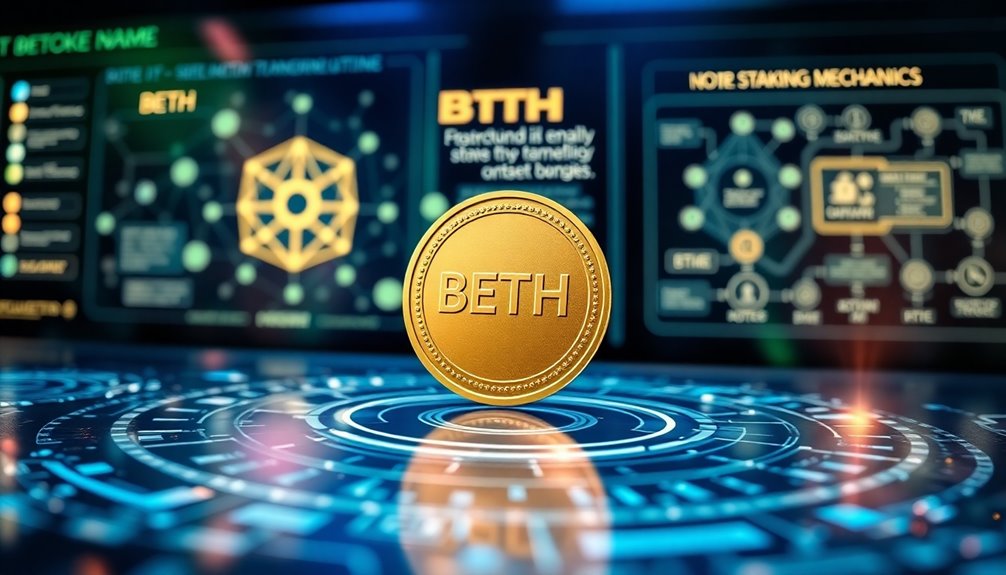BETH is a wrapped token by Binance that represents staked ETH, allowing you to access liquidity and earnings from Ethereum 2.0. Each BETH equals one staked ETH, which means you can participate in DeFi applications and earn rewards. It enhances your investment flexibility, letting you trade your locked ETH during the Ethereum 2.0 lock-in phase. While you can redeem BETH for ETH later, it also offers opportunities within decentralized finance, enhancing your asset management. If you're curious about how BETH works in the wider crypto ecosystem, there's a lot more to explore.
Key Takeaways
- BETH is a wrapped token by Binance, pegged 1:1 to Ethereum (ETH) for trading flexibility.
- Each BETH represents one staked ETH, allowing participation in ETH 2.0 staking.
- BETH can be used across the Binance platform and Binance Smart Chain for DeFi applications.
- Holding BETH provides staking rewards from Binance's ETH 2.0 staking node.
- BETH offers liquidity during Ethereum 2.0 lock-in, but may trade at a value different from ETH.
Conceptual Overview of BETH

BETH is an innovative financial tool that bridges the gap between staking and liquidity for Ethereum holders. This wrapped token, issued by Binance, is pegged 1:1 to Ethereum (ETH) on the Ethereum blockchain.
By converting your locked ETH into BETH, you gain access to tradable assets during the Ethereum 2.0 lock-in period, enhancing your investment flexibility. Each BETH represents one staked ETH, allowing you to participate in Binance's ETH 2.0 staking while keeping withdrawal options open.
You can use BETH across the Binance platform and Binance Smart Chain (BSC) for various DeFi applications, enabling liquidity provision. Plus, holding BETH means you'll receive staking rewards from Binance's ETH 2.0 staking node, deepening your involvement in the Ethereum ecosystem.
Beth's Role in Defi

As Ethereum holders navigate the challenges of the 2.0 upgrade, BETH plays a significant role in the DeFi landscape.
By converting your locked ETH into BETH, you gain access to a tradable asset that enhances liquidity during the Ethereum 2.0 lock-in period.
Holding BETH enables you to participate in various DeFi applications, such as lending protocols like Venus, where you can generate yield.
Additionally, you can deposit BETH into liquidity pools on platforms like Binance Liquid Swap, earning rewards through liquidity provision.
The tokenized nature of BETH allows you to enjoy staking rewards while retaining flexible withdrawal options, something standard ETH doesn't offer during the lock-in.
You can seamlessly redeem BETH for ETH as the Ethereum 2.0 upgrade progresses.
Beth's Staking Mechanics Explained

Understanding the mechanics of BETH's staking can significantly enhance your experience in the Ethereum ecosystem. BETH is a tokenized representation of staked ETH on Binance, where each BETH equals 1 staked ETH. By holding BETH, you can earn rewards linked to Binance's ETH 2.0 staking node, all while keeping your withdrawal options open.
To get started, you'll need to deposit ETH in increments of 32, which is the minimum for staking on the Beacon Chain. Additionally, BETH offers flexibility; you can convert it back to ETH through Binance's spot market for liquidity during the Ethereum 2.0 transition.
Plus, you can utilize BETH in various DeFi applications on Binance Smart Chain to earn even more rewards.
Pros and Cons of BETH

When considering BETH, you'll find a mix of advantages and drawbacks that can shape your staking experience.
One major pro is that BETH allows you to access liquidity and trade staked ETH, offering flexibility during the Ethereum 2.0 lock-in period. Additionally, holding BETH entitles you to staking rewards from Binance's ETH 2.0 staking node, enhancing your potential earnings.
On the downside, BETH doesn't trade at a 1:1 ratio with ETH, leading to value discrepancies. Plus, you'll face limited redemption options for BETH compared to standard ETH, which may hinder your asset management flexibility.
However, BETH's utility extends beyond staking, as it can be utilized in various decentralized finance (DeFi) applications, adding to its appeal.
BETH Versus Traditional Cryptocurrencies

While traditional cryptocurrencies often lock up your assets during staking periods, BETH offers a unique advantage by allowing you to maintain liquidity.
Each BETH represents 1 staked ETH, making it easier for you to access staking rewards without the withdrawal restrictions that come with traditional ETH. You can trade BETH on Binance and the BNB Smart Chain (BSC), giving you added utility in the DeFi ecosystem, which many traditional cryptocurrencies lack.
Additionally, BETH's price dynamics differ from traditional tokens, as it doesn't trade at a 1:1 ratio with ETH due to unique market conditions.
Plus, holding BETH lets you earn staking rewards, introducing a layer of passive income not typically available with traditional cryptocurrencies.
Market Volatility Impacts BETH

Market volatility can significantly affect BETH, causing its price to fluctuate independently from ETH. Since BETH represents staked ETH, the lack of withdrawal flexibility during the Ethereum 2.0 transition can heighten volatility as traders respond to market conditions.
Sentiment around Ethereum 2.0 upgrades also plays a crucial role in BETH's valuation and trading volume. As a BETH holder, you earn staking rewards, but this can create a gap in perceived value versus ETH based on future gain expectations.
When market volatility spikes, you might notice larger price swings for BETH due to its liquid status as a representation of locked ETH, further influenced by speculative trading behaviors that can amplify these fluctuations.
Emerging BETH Liquidity Pools

Emerging BETH liquidity pools are transforming the way users interact with staked assets in the Ethereum ecosystem. By providing liquidity in ETH/BETH trading pairs, you're enhancing market depth and trading efficiency on platforms like Binance.
These pools allow you to earn rewards from trading fees generated by the BETH market, incentivizing your participation in Ethereum 2.0. When you stake your BETH in these liquidity pools, you can gain additional yields that often surpass traditional staking methods, depending on the pool's performance and demand.
As Ethereum transitions to 2.0, BETH liquidity pools support overall network liquidity, stabilize prices, and offer trading options for staked ETH holders. The growing Ethereum ecosystem will likely increase demand for these vital liquidity pools.
Diversify Your BETH Holdings

To maximize your BETH holdings, it's essential to diversify your investments across various decentralized finance (DeFi) platforms.
Consider using BETH in Binance Launchpool, where you can lock your BETH alongside other assets to earn additional token rewards.
Another strategy is providing liquidity in the ETH/BETH pool on Binance Liquid Swap, which can yield rewards through transaction fees and incentives.
Don't overlook lending protocols like Venus, where you can utilize BETH to generate yields while maintaining exposure to the Ethereum ecosystem.
By exploring these different DeFi applications and investment strategies, you can enhance the overall performance of your BETH portfolio, minimizing risks while maximizing potential returns.
Diversification is key to thriving in the dynamic crypto landscape.
Frequently Asked Questions
What Is Beth Used For?
You can use BETH to earn staking rewards while keeping your trading options open.
Each BETH you hold represents 1 staked ETH, allowing you to participate in Ethereum 2.0 staking without losing flexibility.
You can trade or lend it within various decentralized finance (DeFi) applications after moving it to Binance Smart Chain.
Plus, once withdrawals are enabled, you can redeem BETH for ETH on Binance's spot market whenever you want.
What Is the Full Meaning of Beth?
The full meaning of BETH is "Binance Ether."
It’s a token that represents staked Ether (ETH) on the Binance exchange. You can think of it as a bridge between staking and trading, allowing you to earn rewards while still having the flexibility to manage your assets. Additionally, this token enables you to access liquidity without sacrificing the benefits of staking. With this innovative approach, users can effectively participate in the growing staking ecosystem while retaining the ability to trade their assets easily. As the cryptocurrency landscape evolves, many investors are curious about what is an initial exchange offering, as it presents another avenue for raising funds and launching new projects.
This means you can actively participate in the Ethereum 2.0 ecosystem without locking up your funds entirely, giving you more options for your investments.
Is Beth the Same as ETH?
Think of BETH as a unique flower in a garden, distinct from the larger, more common blooms of ETH.
No, BETH isn't the same as ETH. While both are tied to Ethereum, BETH represents staked ETH and offers staking rewards, maintaining some liquidity during the Ethereum 2.0 transition.
However, you can't directly cash out BETH like ETH; it needs conversion through the Binance spot market, creating different trading dynamics.
What Is the English of Beth?
When you ask about the English of "Beth," you're looking at a name that's often a short form of Elizabeth or Bethany.
It's derived from the Hebrew word for "house," symbolizing community and belonging.
Though it's currently less popular, it still carries a warm, approachable vibe.
If you're considering names, "Beth" could be a charming choice, especially if you appreciate its historical roots and familial connections.
Conclusion
In the ever-evolving world of DeFi, BETH stands out as a unique asset you might just find fits your portfolio perfectly. Its staking mechanics offer a chance to earn while you hold, and its liquidity pools can enhance your trading strategies. Sure, there are risks, but sometimes the best opportunities come with a little volatility. So, as you explore BETH, remember: diversification could be your ticket to a more balanced crypto journey. Happy investing!









